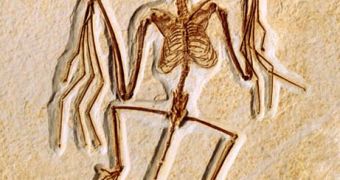The evolution of bats is still a mystery, as the fragile flying mammals have left few fossils behind. A new study published in the journal "Nature" describes the oldest bat ever and what the fossil has revealed: bats first flew, and after that they developed echolocation.
"This new bat [fossil] is clearly a flying animal, but it lacks the features in the skull that we'd expect to see in an echolocating bat," co-author Nancy Simmons, chair of Vertebrate Zoology at the American Museum of Natural History in New York, told National Geographic News.
Bats emit ultrasounds, then listen to their echoes to assess the position of obstacles or prey around. The previously oldest known bat was 50 million years old and was fully capable of flight and displayed physical adaptations for echolocation. Some fossils even preserved stomach content including insects.
"So we know they were flying animals and [were] probably echolocating and catching flying insects," said Simmons. But the new species, Onychonycteris finneyi, 52.5 million years old, encountered in Wyoming's fossil-rich Green River formation, had wings capable of flight, but its anatomy of the ear was not adapted for using a sonar.
Common theory had stated that small arboreal mammals developed echolocation to detect their prey insect in midair; in time, these animals would have grown longer arms and digits for leaping, later gliding, chasing their prey, and in time they passed to full-flapping flight.
"We don't know for sure, but what makes the most sense in terms of the evolution of flight is that bats evolved from a gliding ancestor, something similar to a gliding squirrel. The hypothesis for bat flight is that it evolved as a means to expand their range and maneuverability to find food and escape predators," Simmons added.
Onychonycteris was also a good climber, fact proved by its limb proportions and claw-tipped fingers.
"Probably what it was doing was flying to get from place to place, landing in some vegetation, and then climbing around looking for food. As a bat that can't echolocate, it probably wasn't chasing food in the air but listening for prey-generated sounds [like a beetle hitting a leaf]. That's the way that some living bats hunt, even using echolocation for navigation," said Simmons.
One puzzle persists: was Onychonycteris a nocturnal animal, like modern bats? Some bats, 60 million years ago, could have evolved towards echolocation, while others could have used night vision. The newly found fossils is of no use in this aspect.
"The eye sockets were crushed, so it can't be determined if they were enlarged as in other nocturnal, non-echolocating animals. The possibility is there that bats were originally [awake during the day] and were forced into the nocturnal niche by the appearance of avian predator species some 50 to 60 million years ago," John Speakman, the chair of zoology at the University of Aberdeen in the United Kingdom, not involved in this research, told National Geographic News.

 14 DAY TRIAL //
14 DAY TRIAL //